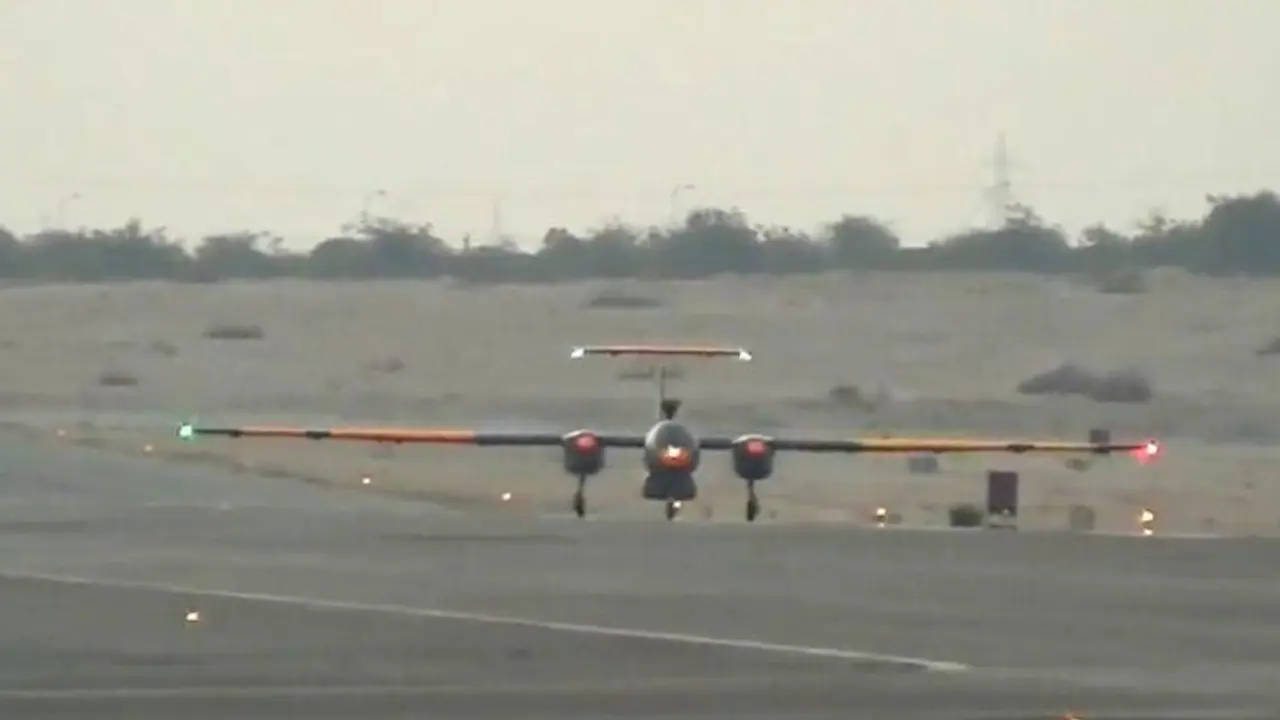The Tapas UAV flew for 3 hours and 30 minutes at an altitude of 20,000 feet above sea level, with the INS Subhadra effectively taking over control of the UAV’s activities for 40 minutes throughout the demonstration, says Girish Linganna
The Defence Research and Development Organisation (DRDO) and the Indian Navy recently successfully demonstrated the transfer of command and control capabilities (C2) of the Tactical Aerial Platform for Advanced Surveillance -- Beyond Horizon 201 (TAPAS BH-201) Unmanned Aerial Vehicle (UAV) from a remotely situated ground station to onboard the INS Subhadra, a warship located 148 kilometres from the Karwar naval installation.

The path-breaking feat took place on Friday, June 16, 2023. The Tapas UAV took flight at 07:35 am from the Aeronautical Test Range (ATR) in Chitradurga and travelled 285 km to the Karwar naval base. One Ground Operation Station and two Ship Data Terminals were installed aboard the INS Subhadra to permit the seamless operation of the UAV, according to a DRDO release. The Tapas UAV landed safely back at the ATR after the successful trial.
WHY IS THE C2 TRANSFER TEST SIGNIFICANT?
The Tapas test successfully tested the transfer of command and control capabilities of the Tapas from a ground station to onboard INS Subhadra located 148 kilometres away from the Karwar naval base. The command and control (C2) capabilities of a drone refer to the ability of the operator to control the drone’s flight, sensors and payload. C2 capabilities are essential for the safe and effective operation of a drone.
There are two main types of command and control capabilities. They are:
* Remote control: The operator uses a remote control device to send commands to the drone and so, can control the drone’s flight, sensors and payload.
* Autonomous flight: The drone flies autonomously, following a pre-programmed flight plan or using onboard sensors to navigate its environment. The operator can still send commands to the drone, but the drone is not under the operator’s direct control.
The C2 capabilities of a drone are determined by a number of factors, including the type of drone, mission requirements and the operating environment.
Good command and control capabilities can help prevent accidents and incidents. For instance, if the operator loses control of the drone, the drone can be automatically returned to its home location. It can also help improve the efficiency of drone operations. For instance, the operator can use the drone’s sensors to identify targets and the drone’s payload to deliver weapons or other payloads. Besides this, enhanced command and control capabilities can help the operator maintain situational awareness of the drone’s location and its surroundings. This can be important for avoiding obstacles and also avoiding hostile fire.
A NEW ERA IN INDIAN DEFENCE
TAPAS UAV is a medium-altitude, long-endurance (MALE) UAV developed by the DRDO. TAPAS UAV is equipped with a variety of sensors, including radar, electro-optical/infrared (EO/IR) camera and synthetic aperture radar (SAR).
It can be used for a variety of missions, including surveillance, reconnaissance and target acquisition. In simple words, TAPAS UAV is a ‘flying eye’ that can be used to keep an eye on things from a distance. It can be used to monitor enemy movements, track down criminals, or even provide disaster relief.
In 2016, the TAPAS BH-201 conducted its first flight. The TAPAS BH-201 is supposed to have a maximum endurance of 24 hours at an altitude of 35,000 feet. It can be operated using satellite communication from 1,000 km away. It took another five years (2021) for TAPAS, a Medium-Altitude Long Endurance (MALE), to demonstrate an endurance of 18 hours and a flight altitude of 28,000 feet. This, however, is still short of the army’s stated requirement.
The TAPAS BH-201 uses two NPO Saturn 36MT turboprop engines of Russian origin in a puller configuration compared to the one-engine pusher configuration of the Rustom-1.
In July 2022, the government ordered Hindustan Aeronautics Limited (HAL) to manufacture six TAPAS UAVs for evaluation trials, with a delivery date of April 2023. Months later, there is no confirmation on the status of these drones either from the DRDO or HAL or from the army.
The TAPAS surveillance drone made its debut public flight earlier this year at Aero India, 2023, in Bengaluru. This platform, designed to meet the Tri-Services Intelligence, Surveillance, Target Acquisition, Tracking and Reconnaissance (ISTAR) requirements, can operate well in both day and night settings.
The UAV can be operated autonomously or remotely controlled, carrying out flight plans that are pre-programmed with accuracy and flexibility. TAPAS can capture high-resolution photos and films thanks to enhanced sensors and cameras. The collected data is relayed to a ground control station for analysis.
LONG-RANGE ELECTRO-OPTICS
Electro-optics and long-range electro-optics are sensors that use light to capture images and videos. Synthetic aperture radar is a radar system that uses a technique called synthetic aperture to create high-resolution images. These sensors are used on the TAPAS drone to provide surveillance and reconnaissance capabilities.
Electro-optic sensors use visible light to capture images and videos. They can be used in day or night conditions and can provide high-resolution imagery. Long-range electro-optics sensors are a type of electro-optics sensor that can capture images and videos from long distances. They are used for surveillance and reconnaissance missions and can provide information about enemy movements and activities
Synthetic aperture radar (SAR) is a radar system that uses a technique called synthetic aperture to create high-resolution images. SAR can be used in all weather conditions and it can provide information about the ground surface—such as terrain features and objects.
The TAPAS UAV is a significant achievement for India’s defence industry. It is the first indigenously developed MALE UAV that can meet the requirements of the Indian armed forces. TAPAS UAV is a versatile platform that can be used for a variety of missions. It is a valuable asset for India’s military and will play an important role in protecting the country’s security.
